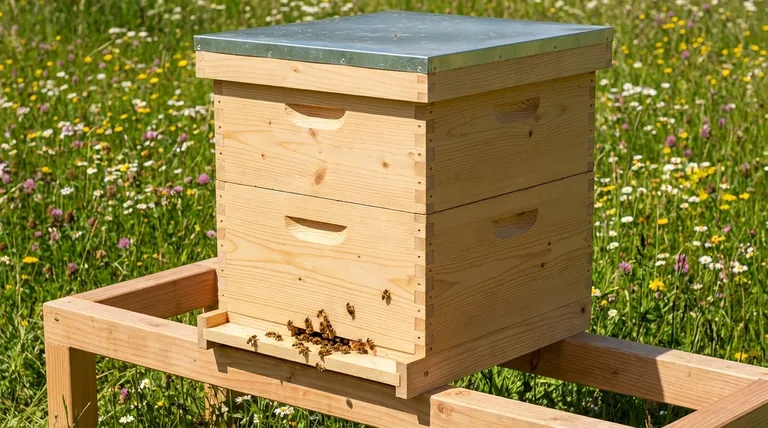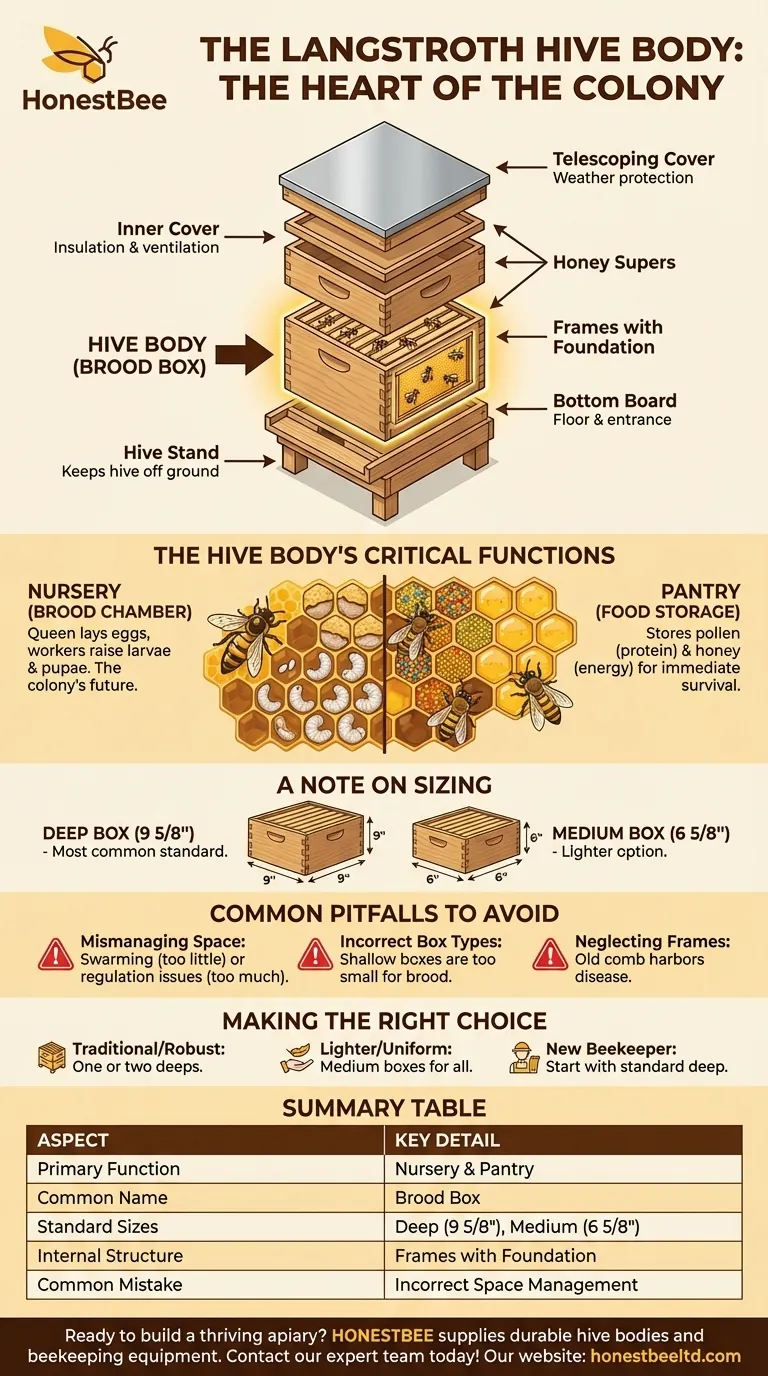In simple terms, a hive body is the primary box in a Langstroth beehive that serves as the colony's living quarters. Often called the "brood box," this is where the queen bee lays her eggs and where worker bees raise the young (the brood). It also functions as the main pantry, storing the pollen and honey the colony needs for its immediate survival.
The hive body is not just a component; it is the heart of the hive. Understanding its role as the combined nursery and pantry is fundamental to managing a healthy, productive honey bee colony.

The Hive Body in the Context of the Hive
To fully grasp the hive body's importance, you must see how it fits within the complete Langstroth system. The hive is a modular, vertical structure where each part serves a specific function.
The Foundation of the Hive
A hive is built from the ground up. A hive stand keeps the structure off the damp ground, protecting the wood and giving bees a clear landing area. The hive itself rests on a bottom board, which serves as the floor and entrance.
The Core: The Brood Box
The hive body, or brood box, is the first and most critical chamber stacked on the bottom board. It is the center of all colony activity. This is where the queen performs her primary function, and where the next generation of bees is nurtured.
Internal Structure: Frames and Foundation
Inside the hive body are removable frames. Each frame is a rectangular structure designed to hold a sheet of foundation—typically beeswax or plastic embossed with a honeycomb pattern. This foundation provides a guide for the bees, encouraging them to build straight, orderly honeycomb for raising brood and storing food.
The Protective Layers
An inner cover sits on top of the uppermost box. It provides insulation and prevents the bees from sealing the main lid shut with propolis. Finally, a telescoping top cover, often clad in metal, shields the entire hive from rain, sun, and other weather elements.
The Hive Body's Two Critical Functions
The hive body isn't just a passive container. It is the active center of the colony's life, serving two co-dependent purposes.
The Nursery of the Colony
The primary purpose of the hive body is to be the brood chamber. The queen moves across the frames, laying eggs in the hexagonal cells of the honeycomb. Worker bees then tend to these eggs as they develop into larvae, pupae, and finally, adult bees. The health and future of the colony depend entirely on the activity within this box.
The Pantry for Survival
The cells immediately surrounding the developing brood are used for storage. Worker bees pack these cells with pollen (protein for feeding larvae) and honey (carbohydrates for energy). This creates a "pantry" that ensures the colony has immediate access to the resources needed to feed itself and its young.
A Note on Sizing
Hive bodies come in different standard depths. The most common is the "deep" box (9 5/8 inches). However, some beekeepers prefer to use "medium" boxes (6 5/8 inches) for their brood chambers because they are lighter and easier to lift when full of honey, brood, and bees.
Common Pitfalls to Avoid
Proper management of the hive body is crucial for success. A few common mistakes can hinder a colony's progress.
Mismanaging Brood Space
Providing too little space can lead the colony to feel crowded, which is a primary trigger for swarming (where the queen leaves with half the bees to find a new home). Conversely, providing too much space too early can make it difficult for the colony to regulate temperature and defend its home from pests.
Using Incorrect Box Types
While medium boxes can be used for brood, shallow boxes (often used for honey collection) are generally too small. Using a shallow box as a primary brood chamber severely restricts the queen's laying space and can cripple the colony's ability to grow.
Neglecting Frame Maintenance
The frames and foundation inside the hive body are where the work happens. Old, dark comb can harbor diseases, and damaged foundation can lead to chaotic comb construction that makes inspections difficult. Regularly rotating out old frames is a key part of good hive management.
Making the Right Choice for Your Goal
Your approach to the hive body depends on your beekeeping philosophy and physical capabilities.
- If your primary focus is a traditional, robust setup: Use one or two deep (9 5/8") hive bodies for the brood chamber to give the queen ample laying space.
- If your primary focus is lighter weight and uniform equipment: Use medium (6 5/8") boxes for everything, including the brood chamber, allowing all your equipment to be interchangeable.
- If you are a new beekeeper: Start with a standard deep hive body, as most educational material is based on this traditional configuration, making it easier to follow along and learn.
Ultimately, viewing the hive body as the engine room of the colony is the key to understanding its central role in the life of your bees.
Summary Table:
| Aspect | Key Detail |
|---|---|
| Primary Function | Serves as the colony's nursery (brood chamber) and pantry (food storage). |
| Common Name | Brood Box. |
| Standard Sizes | Deep (9 5/8"), Medium (6 5/8"). |
| Internal Structure | Holds frames with foundation for bees to build honeycomb. |
| Common Mistake | Providing too little space (triggers swarming) or too much space (hard to defend). |
Ready to build a thriving apiary? HONESTBEE supplies durable, high-quality hive bodies and beekeeping equipment to commercial apiaries and distributors. Our wholesale-focused operations ensure you get the reliable foundation your bee colonies need to prosper. Let's discuss your specific requirements—contact our expert team today to get started!
Visual Guide

Related Products
- Langstroth Bee Hives Bee Keeping Box for Beginners Beekeeping
- Long Langstroth Style Horizontal Top Bar Hive for Wholesale
- Professional Insulated Plastic Bee Hives
- Multi-Functional Sliding Hive Entrance for Beekeeping
- Wholesales Dadant Size Wooden Bee Hives for Beekeeping
People Also Ask
- What basic equipment is needed to start beekeeping? Your Essential Guide to a Confident Start
- What are the different types of beehive boxes available? Choose the Right Hive for Your Apiary
- Should a beginner try a different type of hive? Start with a Langstroth for a solid foundation.
- Why are Langstroth hives recommended for beginners? Unmatched Support & Standardization
- How does the orientation of the hive sides benefit comb construction? Ensure Straight, Movable Combs for Easier Hive Management



















